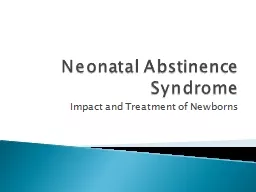

Neonatal Abstinence Syndrome Impact and Treatment of Newborns Addiction is a disease that effects at least two patients A mother with the chronic relapsing disease of addiction that involves biological changes in oxytocin and dopamine in the brain resulting in disorders of attachment and reward ID: 762650
Download Presentation The PPT/PDF document "Neonatal Abstinence Syndrome Impact and ..." is the property of its rightful owner. Permission is granted to download and print the materials on this web site for personal, non-commercial use only, and to display it on your personal computer provided you do not modify the materials and that you retain all copyright notices contained in the materials. By downloading content from our website, you accept the terms of this agreement.
Neonatal Abstinence Syndrome Impact and Treatment of Newborns
Addiction is a disease that effects at least two patients: A mother with the chronic, relapsing disease of addiction that involves biological changes in oxytocin and dopamine in the brain, resulting in disorders of attachment and reward An infant Impacted by the effect of drug exposure in utero and potentially by withdrawal and further drug exposure after birth With immediate needs for permanence and stability impacted by potential disorders of attachment and bonding of the mother A different kind of epidemic
More likely T o be born preterm To have lower birth weights and lower head circumferencesTo require resuscitationTo be admitted to a SCN or NICUImpacts In Utero and At Birth
Risk for withdrawal Prolonged hospitalization Medical treatment with further drug exposure to the developing brainThree fold higher risk for child abuse and neglectIncreased risk for developmental delays, learning disabilities and behavior problems Babies with poor in utero growth have increased incidences of heart disease, hypertension, and type 2 diabetes mellitus as adults The infant’s future ability to mother, via epigenetic modifications of gene expression, may be impacted Impacts after birth
Attachment is an innate biological system promoting contact between an infant and mother, in order to increase the likelihood of survival Changes in oxytocin and dopamine during pregnancy and lactation prime the mother to attach to and nurture her infant Infant contact stimulates oxytocin release, which may result in activation of the dopamine reward pathway, reinforcing the maternal response to the infant’s social cuesImpact on the Infant – The Biology of Attachment
Stress during pregnancy may reduce oxytocin receptor binding, and chronic drug abuse reduces oxytocin levels Mom’s dopamine response does not occur normally due to the impact of drug abuse on the dopamine reward system. Naturally rewarding behaviors no longer have the normal impact on mom to reinforce those behaviors Either results in increases in maternal anxiety and decreased maternal bonding behavior. Decreased maternal bonding behavior may then result in decreased oxytocin receptor binding in the offspring.The Biology of Attachment
Early maternal caregiving influences the infant’s programming of the oxytocin and dopamine neuroendocrine systems, which then influences that infant’s maternal behavior in adulthood A neglected infant is biologically vulnerable to become a neglectful motherThe Biology of Attachment
Urine – Detects only recent use Need first void to get highest concentrationValues set for adults – may give false negatives for infants MeconiumNeed ALL meconiumMust be mixed before testing Rarely done correctly in collection or at lab Cord Easy to collect Most sensitive/accurate Quicker than waiting to collect all meconium Toxicology
A constellation of symptoms characterized by Central nervous system irritability Excessive/continuous crying – may be high pitchedDifficulty sleepingHyperactive moro, increased muscle toneTremors, disturbed and/or undisturbed Myoclonic jerks, seizuresAutonomic over-reactivitySweatingFever Nasal stuffiness, sneezing, frequent yawning, mottlingNasal flaring, increased respiratory rateGastrointestinal tract dysfunctionFrequent sucking Poor feeding Regurgitation, projectile vomiting, loose or watery stools Most often measured using the Finnegan NAS Scoring Tool Withdrawal Symptoms
Any positive screen during this pregnancy or admitted history of opiate or other drug use – baby will be scored in nursery for minimum of 5 days If scores remain below 8 and infant otherwise doing well, discharged to home with follow up If scores are greater than 10 for two consecutive times, infant transferred to NICU Treatment Protocols
Neonatal Abstinence Syndrome Detoxification Flow Chart - Opiate Exposure Then increase clonidine if scores remain above 10. Transfer to NICU
Weaning Phase
Since implementing our protocol have seen Decrease in length of stay from 50.4 to 25.1 for term babies Reduced length of exposure to drugsMorphine exposure decreased from 30.3 days to 17.4Clonidine exposure decreased from 44.3 days to 20.1Reduction in Length of Stay
Parental presence is a key part of the treatment! Parental contract reviewed and signed explaining importance of their presence – for most if not all of the time. Shown to reduce medication use, weaning time, length of stayPotential to improve bondingWill monitor for compliance issues and for impacts on medication use and length of stayParental Involvement
Discharge Criteria Off morphine for 48 hours Off clonidine for 24 hoursStable phenobarbital weanScores of 8 or less for 24 hours Consistent weight gainHome Therapy Candidate on phenobarbGood social situationA score of 7 or less for 24 hoursConsistent weight gain Able to wean phenobarbital two times consecutivelySafety plans in place with CPS follow upDevelopmental referrals in place Discharge Planning and Follow Up